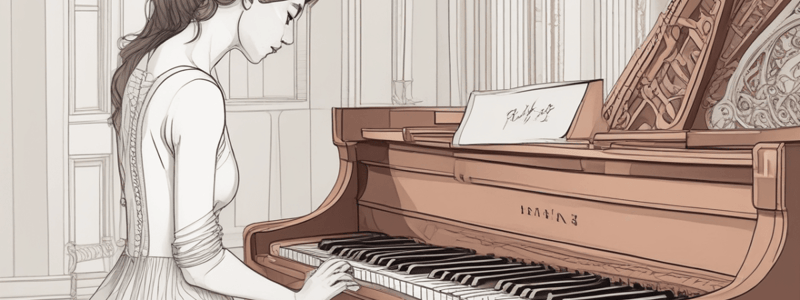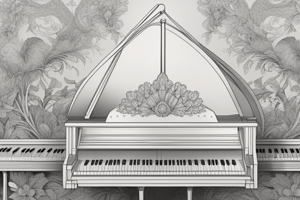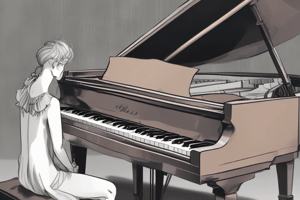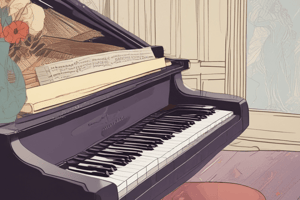Podcast
Questions and Answers
What is the purpose of proper hand positioning in piano playing?
What is the purpose of proper hand positioning in piano playing?
- To play the piano with speed
- To learn complex piano pieces
- To play with loud dynamics
- To develop good technique and prevent injury (correct)
How should you place your hands on the keyboard?
How should you place your hands on the keyboard?
- Palms facing sideways and fingers bent
- Palms facing down and fingers curved (correct)
- Palms facing up and fingers bent
- Palms facing up and fingers straight
What should you imagine holding in your hand to maintain a rounded hand shape?
What should you imagine holding in your hand to maintain a rounded hand shape?
- A small book
- A small ball or an imaginary apple (correct)
- A pencil
- A small toy
What should you avoid in your wrist position?
What should you avoid in your wrist position?
What is the role of your thumbs in hand positioning?
What is the role of your thumbs in hand positioning?
What should you do with your fingertips while playing?
What should you do with your fingertips while playing?
What is the primary purpose of finger numbering in piano playing?
What is the primary purpose of finger numbering in piano playing?
What should you maintain when playing chords?
What should you maintain when playing chords?
Why is practicing proper hand positioning essential for pianists?
Why is practicing proper hand positioning essential for pianists?
What should you avoid when playing chords?
What should you avoid when playing chords?
What is the main goal of developing finger independence?
What is the main goal of developing finger independence?
How should you practice finger independence?
How should you practice finger independence?
What is the purpose of practicing legato technique?
What is the purpose of practicing legato technique?
What should you do when playing staccato technique?
What should you do when playing staccato technique?
Why is regular practice essential for piano playing?
Why is regular practice essential for piano playing?
What should you do when playing black keys?
What should you do when playing black keys?
What is essential to ensure accurate and musical piano playing?
What is essential to ensure accurate and musical piano playing?
What should you focus on to produce a consistent and articulate sound?
What should you focus on to produce a consistent and articulate sound?
What is the purpose of practicing with a metronome?
What is the purpose of practicing with a metronome?
How should you approach challenging passages in your practice?
How should you approach challenging passages in your practice?
What is necessary for mastering the piano?
What is necessary for mastering the piano?
What is the importance of articulation in piano playing?
What is the importance of articulation in piano playing?
What is essential for efficient piano playing?
What is essential for efficient piano playing?
How can you improve finger strength outside of playing?
How can you improve finger strength outside of playing?
What is finger agility?
What is finger agility?
How can you develop finger agility?
How can you develop finger agility?
What is the purpose of maintaining a relaxed yet attentive posture?
What is the purpose of maintaining a relaxed yet attentive posture?
How should you place your hands and fingers on the keyboard?
How should you place your hands and fingers on the keyboard?
What is the definition of legato playing?
What is the definition of legato playing?
What is the purpose of dynamics in piano playing?
What is the purpose of dynamics in piano playing?
What is the most commonly used pedal in piano playing?
What is the most commonly used pedal in piano playing?
What is the benefit of consistent practice in piano playing?
What is the benefit of consistent practice in piano playing?
Flashcards are hidden until you start studying
Study Notes
Proper Hand Positioning for Piano Playing
- Sit at the piano with relaxed arms and a straight back
- Place hands on the keyboard, palms facing down, and fingers slightly curved
- Position thumbs on or near the middle of the keyboard, resting on the "Middle C" key
- Spread fingers out naturally, allowing each finger to rest on a key
- Maintain a rounded hand shape with curved fingers, avoiding stiffness or tension
- Keep fingertips in contact with the keys, ensuring a clear transfer of energy when playing
- Keep wrists relaxed and parallel to the floor, avoiding excessive upward or downward bending
- Ensure thumbs play a supporting role, keeping them relaxed and slightly lower than the other fingers
- Distribute weight evenly among fingers when playing chords, maintaining a curved hand shape
- Develop finger independence by practicing exercises that involve playing different notes simultaneously with each finger
Finger Numbering and Technique
- Each finger is assigned a number from 1 to 5, starting from the thumb
- Memorize and practice finger numbering by playing scales and simple exercises, focusing on each finger individually
- Establish proper hand positioning before diving into finger technique
- Legato technique involves playing notes smoothly and connected, maintaining a slight overlap between notes
- Staccato technique involves playing notes in a short and detached manner, lifting fingers quickly off the keys
- Develop finger independence by practicing exercises that focus on each finger individually
- Build finger strength by playing chromatic scales and using finger strengthening tools
- Enhance finger agility by practicing scales, arpeggios, and technical exercises at a slow tempo, gradually increasing the speed
Piano Playing Techniques
- Good posture and proper positioning are essential for efficient piano playing
- Maintain a relaxed yet attentive posture, with both feet flat on the floor and the bench at the correct height
- Curve fingers slightly, keeping wrists level with the keyboard and elbows slightly bent
- Develop finger independence by practicing simple finger exercises, such as playing scales, arpeggios, and chords
- Legato playing involves smoothly transitioning from one note to another without any breaks or pauses
- Staccato playing involves playing short, crisp notes with brief pauses between them
- Dynamics refer to the variation in volume and intensity of the music while playing
- Pedal techniques allow for sustaining certain notes or chords, adding richness and resonance to the playing
- Articulation refers to how we attack and release notes, focusing on crisp and clean playing
- Rhythm and timing are essential aspects of piano playing, developing a sense of rhythm through practice with a metronome
- Regular practice is key to mastering piano playing, setting aside dedicated practice time and establishing a consistent routine
Studying That Suits You
Use AI to generate personalized quizzes and flashcards to suit your learning preferences.




